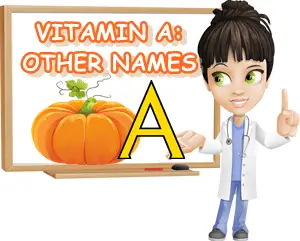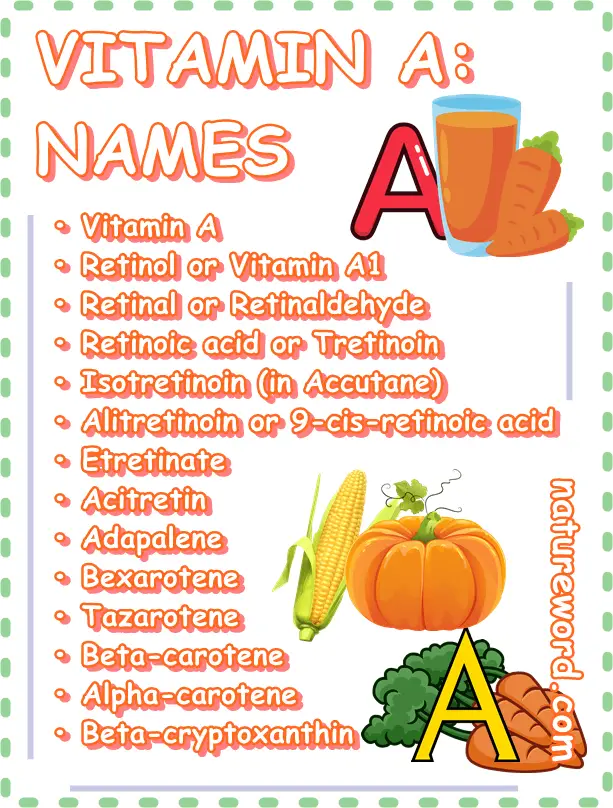Vitamin A is a vitamin everyone knows.
It’s advertised predominantly for its benefits for eyesight and skin, and orange foods such as carrots and pumpkin are the best known food sources for it.
Most people know it by the names vitamin A and retinol.
But these are not the only names for vitamin A, and definitely not the only forms.
What else is vitamin A called? What are its more scientific names? How many other names does vitamin A have? Are there different types of vitamin A? Are the different names for vitamin A synonymous or does each name denominate a specific form of the vitamin?

Vitamin A names
1- Vitamin A
Vitamin A is the common name for the vitamin. It is used to denominate all forms and types of vitamin A in informal language, both retinoids and carotenes.
While the use of the name as a synonym for all constituents that have vitamin A activity can be considered inexact, it is not incorrect nonetheless as any constituent that has vitamin A activity in the body is a form of vitamin A via its functions.
2- Retinol or Vitamin A1
Retinol is the second most common name for vitamin A and a very specific form of the vitamin. Retinol is a form of vitamin A occurring naturally in foods, but also present in dietary supplements.
It’s also called Vitamin A1, but this is a less known name. Retinol was discovered at the start of the 1900s, and 4o years later it was produced synthetically for the first time.
Retinol as a form of vitamin A both occurs naturally in food, and is available as synthetic retinol.
Animal foods that are natural sources of retinol include liver such as fish liver, and fish liver oils, liver (turkey liver, chicken liver, beef liver, pork liver), butter, eggs and cheese.

3- Retinal or Retinaldehyde
Retinal is another name for vitamin A. Retinal is a particular and quite interesting form of vitamin A. It can be obtained in the diet directly from animal foods such as meat.
However, the human body can also produce retinal from compounds found in plant foods.
More exactly, humans can make retinal from pigmented carotene antioxidants such as beta-carotene and alpha-carotene, and from pigmented xanthophyll antioxidants such as beta-cryptoxanthin.
Beta-carotene, alpha-carotene and beta-cryptoxanthin are pro-vitamin A antioxidants, that is, antioxidants that serve vitamin A functions in the human body.
What’s more interesting is the fact that the human body can also make retinol and other forms of vitamin A from retinal it gets from sources such as meat.
4- Retinoic acid or Tretinoin
Retinoic acid is a form of vitamin A made from the pigmented carotene antioxidant with vitamin A activity called beta-carotene.
Retinoic acid is a medicine.
It was first developed in the 1960s and its main uses include treating acne, and acne side effects such as hyperpigmentation, and a form of leukemia called acute promyelocytic leukemia.
Vesanoid, Avita, Renova and Retin-a are just a few of the names that retinoic acid is marketed under.
5- Isotretinoin (in Accutane)
Isotretinoin is the form of vitamin A in the popular acne medication Accutane.
It’s also known by the name 13-cis-retinoic acid. It is used for the treatment of severe and resistant forms of acne, including cystic acne, but also other skin disorders and cancer.
Isotretinoin is known to cause birth defects and other severe, sometimes permanent side effects.
6- Alitretinoin or 9-cis-retinoic acid
Alitretinoin, also known as 9-cis-retinoic acid, is a form of vitamin A used as medication.
Its primary uses include treating severe skin disorders such as resistant eczema, and cancer.
7- Etretinate
Etretinate is another name for vitamin A. Etretinate denominates a particular form of vitamin A that is used as a medicine.
Like most other vitamin A formulations for medical use, it is meant for the treatment of skin disorders. In many countries it has been taken off the market.
8- Acitretin
Acitretin is another name for vitamin A. Acitretin denominates a form of vitamin A used as medication primarily for the treatment of skin disorders. It has very specific uses, but also serious side effects which is why it has been taken off the market in many countries.
9- Adapalene
Adapalene is a form of vitamin A used as topical medication. It was developed specifically for the treatment of skin conditions such as acne, keratosis pilaris (goose bumps) and calluses.
But its medical uses span to include other skin conditions and disorders such as hyperpigmentation issues, pre-cancerous lesions of the skin (actinic keratoses), and warts (e.g. warts, water warts, plantar warts), but also bald spots (alopecia areata).
10- Bexarotene
Bexarotene is a form of vitamin A used as medicine. Its primary uses include cancer treatment e.g. non-Hodgkin’s Lymphoma such as T-cell lymphoma, breast cancer and also lung cancer.
Bexarotene has also been tested for potential use in multiple sclerosis treatment, with clinical studies showing it can trigger remyelination of nerve cells that have lost their protective myelin sheath.
11- Tazarotene
Tazarotene is a form of vitamin A used as medication. Its uses include treatment of skin disorders, primarily acne, but also psoriasis. It is available as a topical formula.
12- Beta-carotene
Beta-carotene is a type of carotene, a pigmented red and orange antioxidant, and has vitamin A activity. It is often referred to as a ‘plant form of vitamin A’ due to the fact that it occurs almost exclusively in plants and performs vitamin A functions in the body.
However, beta-carotene is not YET vitamin A. Beta-carotene is a precursor to vitamin A, or a previtamin A. That means that it only performs vitamin A-specific functions in the body after it’s been ingested, metabolized and converted into another form.
In the human body, beta-carotene gets converted into the biologically active form of vitamin A called retinol, and only them performs vitamin A functions. That’s why it’s usually called ‘provitamin A’, to make its previtamin status clear.
Factually, beta-carotene is an inactive form of vitamin A – as it occurs naturally, it does not have vitamin A activity. But upon ingestion, it is processed by the body in a way that converts it to actual vitamin A (retinol).
Beta-carotene conversion to actual vitamin A is not 100% effective. Only a part of all the beta-carotene ingested is converted to vitamin A. This rate of conversion varies greatly and depends on a person’s requirements for vitamin A (the higher the requirements for vitamin A, the more beta-carotene will be converted by the body to fulfill requirements and vice-versa), how much beta-carotene they ingest, dietary habits (eating foods that are sources of beta-carotene with fat can increase conversion into vitamin A) etc.
What are food sources of beta-carotene?
Beta-carotene occurs naturally in both edible and non-edible plants. All orange and most red foods are typically high in beta-carotene.
For example: pumpkin, butternut squash, gourds with orange flesh, orange-fleshed watermelon, orange carrots, orange-fleshed sweet potatoes, red peppers and especially paprika, persimmons (fresh and dried), papaya (fresh and dried), rose hip berries etc.
Dark green foods are also high in beta-carotene, but the orange-red pigment is masked in them. For example: spinach, collards, kale, beet greens, dandelion leaves, turnip leaves, beet leaves, broccoli leaves, mustard greens, grape leaves, lettuce, but also seaweed and green herbs such as parsley, lovage, marjoram, cilantro or coriander.
13- Alpha-carotene
Alpha-carotene is also one of the natural forms of vitamin A, but it’s not yet vitamin A either. Alpha-carotene is closely related to beta-carotene: both are pigmented red and orange carotene antioxidants with vitamin A activity. You can find alpha-carotene in the same foods as beta-carotene.
Just like beta-carotene, alpha-carotene is a precursor to vitamin A, also called pro-vitamin A. But it has an even lower conversion rate compared to beta-carotene. That means that alpha-carotene is converted to vitamin A less than beta-carotene.
14- Beta-cryptoxanthin
Beta-cryptoxanthin is another ‘natural form’ of vitamin A. Ict’s a precursor to vitamin A or a previtamin A or provitamin A.
It’s a pigmented antioxidant, but a xanthophyll, not a carotene like alpha and beta-carotene. It’s nonetheless related to them.
Beta-cryptoxanthin has an even poorer conversion rate than alpha and beta-carotene.
The difference is that beta-cryptoxanthin is found in both plant foods and animal foods.
You can find it in orange and red foods, dark green foods, and yellow foods too (e.g. corn, sweet corn, yellow tomatoes, yellow peppers, yellow carrots and yellow-fleshed watermelon, peaches, nectarines, oranges and orange juice), as well as animal foods such as egg yolk, mayo made with eggs, butter and chicken fat.
- Also see what are other names for vitamin B1.
- Also see what are other names for B vitamins.
